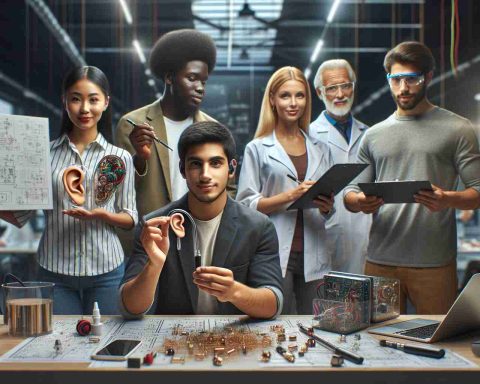In a remarkable tale of ingenuity, a group of three friends recently turned their frustration into innovation. When 24-year-old Rithwik Jayasimha learned that the eagerly awaited hearing aid feature in the new AirPods Pro 2 was unavailable in India, his excitement quickly soured. Determined to overcome this setback, he teamed up with his friends, Arnav Bansal and Rithwik Ribhu, all of whom shared similar sentiments about the barriers their grandmothers faced with traditional hearing aids.
They gathered in a lab in Koramangala, diving deep into a brainstorming session to devise a way to unlock the feature. Understanding that the AirPods gauge location not by GPS but through Wi-Fi signals, they set to work on a clever solution. With materials including aluminum foil, copper mesh, and a microwave, they fashioned a Faraday cage—a device that blocks electromagnetic fields. This clever construction allowed them to manipulate the AirPods’ perceived location, effectively making it appear as though they were in San Francisco.
After successfully enabling the feature, they gifted the AirPods to their grandmothers, transforming their audio experience. Their groundbreaking achievement quickly gained attention online, leading to numerous requests for help from others facing the same issues. The trio, dubbed the ‘Lagrange Point’ lab team, is now exploring further projects, such as developing technology to detect microplastics in food and water, showcasing their commitment to using technology for societal benefit.
Young Innovators Outsmart Apple to Create Hearing Aid Solution
In a world where technology often falls short in accessibility, a trio of young innovators has turned barriers into breakthroughs. Rithwik Jayasimha, Arnav Bansal, and Rithwik Ribhu are not just friends; they are pioneers who are taking matters into their own hands, demonstrating the power of creativity in addressing real-world challenges. While they notably hacked the AirPods Pro 2 to unlock a hearing aid feature, their journey reflects broader implications about innovation, accessibility, and the role of corporate responsibility.
Key Questions and Answers
1. What motivated the trio to innovate?
– Their primary motivation was a mix of personal experience and empathy; the friends observed how their grandmothers struggled with traditional hearing aids, which often come with high costs and limited functionality.
2. What makes their solution significant beyond the personal use?
– Their workaround is indicative of a larger movement towards democratizing technology. It raises questions about the responsibilities of large tech companies like Apple in making their innovations accessible to consumers worldwide.
3. How does their innovation challenge existing tech norms?
– By using inexpensive materials to create a DIY Faraday cage, they highlighted that innovative solutions can emerge from grassroots efforts, often exceeding the current technological offerings of major corporations.
Key Challenges and Controversies
– Legal and Ethical Concerns: The act of circumventing a company’s intended use of a product—such as exploiting hardware limitations—hints at a blurred line between creativity and infringement of intellectual property rights. This raises ethical questions about ownership and innovation.
– Quality and Safety: Their solution, while innovative, does not undergo rigorous testing that commercial products do. There may be concerns regarding the long-term reliability and safety of such a DIY fix, especially for vulnerable populations like the elderly.
– Market Dynamics: The trio’s success could inadvertently fuel debates about affordability in the tech space, pressuring large corporations to rethink their pricing models. However, this informal innovation model might also complicate existing academic and business pathways.
Advantages and Disadvantages
Advantages:
– Affordability: The innovation provides a budget-friendly alternative to conventional hearing aids, which can be costly and difficult to acquire, especially in developing regions.
– Accessibility: It underscores the importance of making technology accessible to underserved populations, motivating a broader discourse on inclusivity.
– Community Engagement: It has sparked interest in DIY tech solutions, encouraging others to think creatively and collaborate to solve shared problems.
Disadvantages:
– Regulatory Issues: Without proper regulations, users may put themselves at risk by using non-certified methods and materials.
– Limited Longevity: The longevity of DIY solutions can be questionable, potentially necessitating frequent modifications or replacements.
– Lack of Support: DIY solutions often lack customer support or warranty, which can lead to frustration for users unfamiliar with technology.
The Bigger Picture
The ‘Lagrange Point’ lab team’s adventure is not just about a local solution to a local problem; it resonates globally. As discussions around accessibility in technology continue to gain traction, the actions of these young innovators may inspire other creative minds to tackle similar issues.
The broader industry must consider how to better engage with users and incorporate their feedback into product design and implementation.
For further insights on technology and innovations, you can explore more at TechCrunch.













